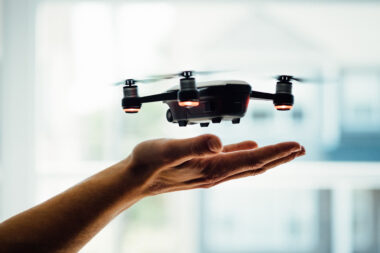In the ever-evolving landscape of assistive technologies, recent advancements in Augmented Reality (AR) are transforming the way visually impaired individuals navigate and interact with the world around them. With the integration of auditory and haptic feedback, coupled with real-time environmental information, AR navigation aids are heralding a new era of independence and accessibility for those with visual impairments.
The Power of Augmented Reality in Navigation:
Traditionally, individuals with visual impairments have relied on canes, guide dogs, or basic navigation apps for assistance. However, the advent of AR technology has introduced a paradigm shift, offering a more immersive and dynamic navigation experience.
AR navigation aids leverage the capabilities of smartphones or wearable devices, providing users with real-time audio cues and haptic feedback. These aids overlay contextual information onto the user’s surroundings, creating a more detailed and interactive understanding of the environment.
Auditory Guidance:
One of the pivotal advancements in AR navigation for the visually impaired is the integration of sophisticated auditory guidance systems. Users receive real-time verbal instructions that guide them through their surroundings. For example, the system may announce street names, describe nearby landmarks, and provide step-by-step directions to their destination. This auditory feedback enhances spatial awareness and fosters a greater sense of independence.
Haptic Feedback:
Complementing auditory cues, haptic feedback adds a tactile dimension to the navigation experience. Users can feel vibrations or gentle taps that correspond to different environmental elements. For instance, a distinct vibration might indicate the presence of an obstacle, while a series of taps could signify a change in direction. Haptic feedback not only enhances safety but also allows users to actively engage with their surroundings in a nuanced way.
Real-Time Environmental Information:
AR navigation aids excel in providing up-to-the-minute information about the user’s surroundings. Using a combination of GPS data, sensors, and machine learning algorithms, these systems can identify nearby points of interest, intersections, and potential obstacles. Users can receive instant notifications about nearby shops, public facilities, or changes in the environment, empowering them to make informed decisions on the go.
User-Friendly Interfaces:
To ensure widespread adoption, developers have prioritized creating user-friendly interfaces for AR navigation aids. Intuitive gestures, voice commands, and customizable settings cater to individual preferences, making the technology accessible to users of varying technological proficiency.
AR navigation for visually impaired individuals requires a combination of software and hardware to provide accurate and effective assistance. Here’s an overview of the key elements involved:
Hardware Components:
Smartphones or Wearable Devices:
– Smartphones: Many AR navigation applications are designed to run on smartphones, utilizing their built-in sensors, GPS, and computing power.
– Wearable Devices: Dedicated AR glasses or headsets provide a hands-free experience, overlaying information directly into the user’s field of view.
Sensors:
– GPS and Location Sensors: These sensors provide real-time location data, helping the system understand the user’s position and navigate them accordingly.
– IMU (Inertial Measurement Unit): IMU sensors track the device’s movement, orientation, and acceleration, enhancing the accuracy of spatial information.
Haptic Feedback Devices:
– Vibrating Motors: Incorporated into wearables or attached to the user’s body, vibrating motors provide haptic feedback to convey information such as direction changes or the presence of obstacles.
Audio Output:
– Bone Conduction Headphones or Earbuds: These devices transmit audio through bone conduction, leaving the user’s ears open to environmental sounds while receiving auditory guidance.
Microphones:
– Built-in or External Microphones: Capture ambient sounds for environmental awareness and may support voice commands for hands-free control.
Software Components:
AR Navigation Applications:
– Navigation Algorithms: Advanced algorithms process GPS data, IMU readings, and environmental information to calculate the user’s position and provide navigation instructions.
– Obstacle Detection: Utilizes sensors to identify obstacles in the user’s path and provides alerts or alternative routes.
Speech Synthesis:
– Text-to-Speech (TTS) Technology: Converts textual information into spoken words, delivering real-time auditory guidance to the user.
Haptic Feedback Software:
– Haptic Feedback Algorithms: Determine the type and intensity of haptic feedback based on environmental data and user preferences.
Machine Learning and AI:
– Environmental Recognition: Machine learning algorithms analyze visual and spatial data to recognize and interpret the user’s surroundings, including identifying objects and landmarks.
User Interface:
– Gesture Recognition: Enables users to interact with the system through intuitive gestures for functions such as changing settings or activating specific features.
– Voice Commands: Allows users to control the navigation system through spoken commands, enhancing accessibility and ease of use.
Connectivity:
– Internet Connectivity: Enables real-time updates, additional information about points of interest, and continuous improvement of the navigation system.
– Bluetooth or Wi-Fi: Facilitates communication between the device and additional accessories, such as haptic feedback devices.
Customization and Accessibility Features:
– User Profiles: Allow individuals to customize the system based on personal preferences, such as preferred walking speed, types of alerts, and language settings.
– Accessibility Options: Features such as high contrast, large fonts, or screen reader compatibility enhance accessibility for users with various needs.
Ongoing Trends and Developments
Integration of Edge Computing:
– Trend: To enhance real-time processing and reduce dependence on cloud-based services, there’s a move towards integrating edge computing into AR navigation devices. This enables faster data analysis and quicker response times, crucial for ensuring the safety and efficiency of visually impaired users.
Machine Learning for Enhanced Object Recognition:
– Trend: Continued advancements in machine learning algorithms are expected to improve object recognition capabilities. This includes the ability to identify and provide context about various objects and obstacles in the environment, contributing to a more nuanced and detailed navigation experience.
Enhanced Haptic Feedback Systems:
– Trend: Ongoing developments in haptic feedback systems aim to provide more precise and customizable feedback to users. This includes advancements in wearable haptic devices that can convey richer information about the user’s surroundings, such as the distance and nature of obstacles.
Gesture and Voice Control Refinements:
– Trend: Improvements in gesture and voice control interfaces are anticipated to enhance the user experience. This involves refining recognition accuracy, expanding the range of recognized gestures and commands, and ensuring seamless integration into the navigation system.
Augmented Reality Glasses with Improved Form Factors:
– Trend: Advances in the design and form factors of augmented reality glasses or wearable devices are likely to continue. This includes efforts to make devices more lightweight, comfortable, and socially acceptable, fostering increased adoption among visually impaired individuals.
Localization and Mapping Innovations:
– Trend: Developments in localization technologies, such as SLAM (Simultaneous Localization and Mapping), are expected to contribute to more accurate and reliable navigation. This can include better mapping of indoor spaces and more robust positioning capabilities, especially in areas with limited GPS coverage.
Collaboration with Smart City Initiatives:
– Trend: Increased collaboration between AR navigation developers and smart city initiatives is anticipated. This collaboration could involve integrating navigation systems with city infrastructure, such as smart traffic lights and sensors, to provide more comprehensive and context-aware navigation assistance.
User-Centric Design and Personalization:
– Trend: A focus on user-centric design principles and personalization is likely to drive the development of AR navigation systems. This involves providing users with more options to customize their navigation experience based on individual preferences, needs, and feedback.
Accessibility Standards and Regulations:
– Trend: The establishment and adherence to accessibility standards and regulations for AR navigation technologies are gaining importance. This includes efforts to ensure that these technologies are inclusive and meet the diverse needs of visually impaired users.
Continuous Software Updates and Improvements:
– Trend: Regular software updates and improvements will remain crucial to address user feedback, enhance system performance, and adapt to changes in the technological landscape. Continuous refinement of algorithms and features is expected to be a standard practice.
Challenges and Future Directions:
While the advancements in AR navigation are promising, challenges such as accuracy in complex environments and seamless integration into daily life persist. Ongoing research and development aim to address these challenges, with an emphasis on refining algorithms, enhancing hardware capabilities, and expanding compatibility with different devices.
The integration of AR into navigation aids represents a transformative leap forward for visually impaired individuals, fostering greater independence and inclusivity. As advancements continue to refine the technology, AR navigation holds the potential to revolutionize the way people with visual impairments experience the world, empowering them to navigate confidently and explore new horizons.



